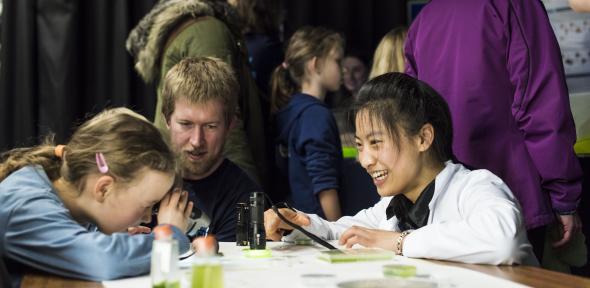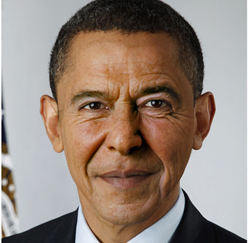
Members of the public had the opportunity to experience the diversity and scope of mathematical research for themselves on Saturday 25 March 2017, as the Centre for Mathematical Sciences opened its doors for the Cambridge Science Festival. With the help of hands-on activities, around 400 visitors to the Faculty's Maths Public Open Day discovered more about what the researchers in this beautiful building get up to in their working lives.
Over 70 volunteer Mathematics Faculty staff and postgraduate students put on a range of hands-on activities that, while accessible even to the youngest visitors, were directly linked to cutting edge research. Aimed at a family audience, from toddlers to pensioners, the Science Festival Maths Public Open Day is the largest public engagement event in the Faculty's year, and is part of the Cambridge Science Festival, the biggest free science festival in the UK.
It is hugely valuable that the public can have direct access to researchers... But events like our Open Day are also valuable for the effect it has on us mathematicians and scientists.Julia Gog
From Lego diseases to the sound of stars
The scope and variety of hands-on activities at the event reflected the huge diversity of research in the Faculty. One of the recurring themes in feedback was how well staff and students explained their research to visitors across the age spectrum. "The postgrads and postdocs did a fantastic job," says Dr Helen Mason OBE, a researcher in Solar Physics, an STFC Public Engagement Fellow, and one of the Faculty's most experienced communicators. "Explaining their research work to the visitors was not easy, but they did this with great enthusiasm and confidence. They seemed to enjoy this activity, were proud of their work and it certainly enhanced their communication skills."
A particularly striking feature of the event was the imagination researchers showed in creating activities that demonstrated key ideas from their work in an accessible and engaging way. The face-fusion photo booth, built by the Cambridge Image Analysis Group, allowed visitors to merge their own face with celebrity photos. As well as being fun, this was a very effective way of building awareness among visitors of the work of the group. At the heart of the face fusion process lies a type of diffusion equation, like the famous heat equation which describes how heat spreads (diffuses) through a material. The diffusion equation used here is more complicated and instead describes how to spread information from the various pixels that make up the image. The techniques behind this popular activity involve deep, cutting edge mathematics, which finds a range of applications, from medical imaging to managing forest ecology.

Who's this? It's a photo of Barack Obama fused with some of Ronald Reagan's features. (Original image by Pete Souza, CC BY 3.0. Image fusion by Martin Benning, Michael Möller, Raz Z. Nossek, Martin Burger, Daniel Cremers, Guy Gilboa, and Carola-Bibiane Schönlieb.)
Meanwhile underground in the GK Batchelor Laboratory visitors had the chance to learn about the topics studied by some of Cambridge's applied mathematicians through a huge range of hands-on fluid dynamics experiments.They were invited to play with alien custard: a cornflour/water solution that, thanks to its non-Newtonian behaviour, writhes, dances and threatens to escape when placed on a functioning loudspeaker. The bewitching motion of granular flows was on display, revealing the mechanisms behind the movements of sand dunes and the dangers of avalanches, and visitors created vortices in tanks, dropped water bombs, made sharks swim in the air and flew planes underwater.
Dr Julia Gog, Reader in Mathematical Biology, talked to over 150 people about "Maths v Disease" in a packed public lecture. Visitors could also explore the potential spread of infectious diseases using Lego with the Disease Dynamics Group. They created their own balloon inflating universes and had a very rare chance to visit the COSMOS supercomputer with the Relativity and Gravitation group and Centre for Theoretical Cosmology. There were also fascinating demonstrations from the Astrophysical Fluid Dynamics Group, whose tools ranged from cutting edge movie simulations to musical beer bottles used to illustrate ideas such as astroseismology - the study of acoustic waves in the interior of stars. Marshmallow catapults were fired on the lawn, and visitors could explore the beauty of number theory through noticing number patterns with Professor Martin Hyland, and playing the factors and multiples game (you can have a go at a similar game yourself).
Communication, passion and inspiration
The scale of the Science Festival event is a clear demonstration of the importance the Faculty places on public engagement as part of its remit. Cambridge mathematicians are well known for their enthusiastic commitment to communicating to wider audiences, including talks at music festivals, popular lectures, a steady stream of popular science books and regular appearances on radio and television to explain the mathematics behind current events. The Faculty is also home to the biggest subject-specific outreach and education programme at the University, including Underground Mathematics, producing free resources to support A level mathematics, and the Millennium Mathematics Project (MMP), which reaches over 11 million users worldwide through its family of online maths education resources and engages thousands of students and teachers in face-to-face activities and events each year.
Events like the Maths Public Open Day allow postgraduate researchers to hone their skill at communicating their work to a wider audience, inspiring the next generation of mathematicians. As part of the two departments' commitment to developing effective transferable skills, the MMP runs public engagement training courses for the researchers and postgraduate students who produce exhibits, and also supports researchers by producing posters helping to give an insight into their work.
The success of this face-to-face engagement with the public was evident in the fact that the majority of visitors stayed for several hours: families were so captivated by the mathematics on offer at this year's Maths Public Open Day they were reluctant to leave at the end of the day!
"Of course it is hugely valuable that the public (of all ages!) can have direct access to researchers, engage in some of our hands-on activities and ask us questions," says Julia Gog. "But events like our Open Day are also valuable for the effect it has on us mathematicians and scientists: to discuss our ideas with a general audience. This makes us step back, for a moment, from our specialist communities and think broadly about what it is we are doing and why. This is really important, for us to keep a view of our work in a bigger picture."
You can learn more about the Faculty's extensive outreach activity with schools and the public here.
